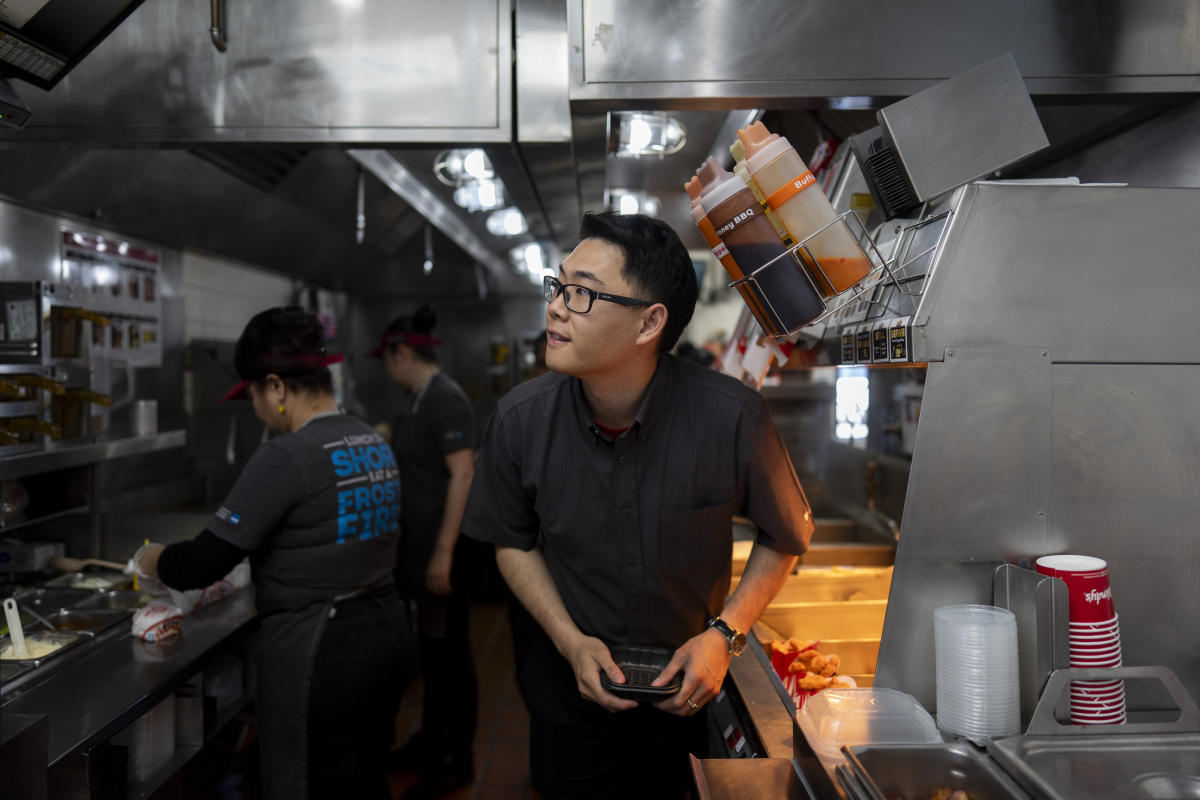
LOS ANGELES (Reuters) – Lawrence Cheng, whose family owns seven Wendy’s restaurants in South Los Angeles, took orders on a recent day, unloaded hot baskets of fries and chicken nuggets and expertly sprinkled them with salt.
Cheng used to have about a dozen employees working an afternoon shift at his Fountain Valley location in Orange County. Now he’s only assigning seven employees to each shift as he tries to absorb a spike in labor costs after New California Law Hourly wages for fast food workers increased on April 1 from $16 to $20 per hour.
“We are reducing staffing as much as we can,” he said. “I schedule one less person, then I come back at a time I didn’t schedule and work that hour.”
Cheng hopes that summer, when business is traditionally brisk as students are out of school and families travel or spend more time eating out, will bring better profits that can cover the extra costs.
Experts say it’s too early to tell what the long-term impact of the wage hikes will be on fast-food restaurants and whether there will be widespread layoffs and closures. Previous wage hikes haven’t necessarily led to job losses. When California and New York nearly doubled their minimum wage to $15 from the federal level of $7.25 an hour, job growth continued, according to the University of California, Berkeley. Stady.
So far, the sector has continued to show job growth. In the first two months after the law was passed on April 1, the sector gained 8,000 jobs, compared with the same period in 2023, according to the U.S. Bureau of Labor Statistics. No figures are yet available for June.
Not only has the industry added jobs under the new law, but many franchisees have also noticed that the higher pay actually attracts better job candidates, thus reducing turnover, said Joseph Bryant, executive vice president of the Service Employees International Union, which pushed for the increase.
But many major fast-food chain operators say they are cutting hours and raising prices to stay in business.
“I’ve been in this business for 25 years and I’ve had two different brands and I’ve never had to increase my pricing like I did last April,” said Juancarlos Chacon, owner of nine Jersey Mike’s locations in Los Angeles.
A turkey sandwich for under $10? Now it’s $11.15. And while customers are still coming in, he sees them slashing their prices—no drinks, no chips, no dessert.
Since their primary business is serving lunch, Chacon began cutting back on morning and evening staff. He also cut part-time staff, dropping from 165 total employees to about 145.
Not only did new employees get pay raises, but shift leaders, assistant managers, and everyone higher up the ladder also had to get pay raises, and labor accounted for about 35 percent of its costs.
“I’m very nervous,” Chacon said.
Aaron Allen, founder and CEO of a global restaurant consulting firm, said he’s been getting panic calls from California restaurant operators and suppliers still recovering from the Covid-19 shutdown. He predicts a growing divide between companies like McDonald’s that have the money to invest in automation and cut costs by “reconfiguring the menu, versus smaller, more regional chains that may go under or face significant store cuts.”
Cheng said he doesn’t plan to lay off any of his 250 Wendy’s workers, but has instead cut overtime and reduced the number of workers on each shift. He also raised menu prices by about 8% in January in anticipation of the law.
However, he said his books show he went over budget by $20,000 during a two-week pay period.
At the same time, businesses are feeling the squeeze from rising rents and food costs, said Jot Conde, president and CEO of the California Restaurant Association, which opposed the minimum wage bill.
“When labor costs go up by more than 25% overnight, any restaurant company with already thin margins is going to have to cut costs elsewhere,” says Conde. “They don’t have a lot of options other than raising prices, cutting hours, or downsizing their workforce.”
Julieta Garcia, who has been working at a Pizza Hut in Los Angeles for a little over a year, said she now works five days instead of six. But she said that’s not a bad thing, as she can spend more time with her 4-year-old son. The extra money means she can pay her cell phone bill on time, instead of having to stop service and take her son for a tonsillectomy, she said.
Howard Lewis, a 63-year-old retiree who works at a Wendy’s restaurant in Sacramento, said he invested his extra money.
“Today was payday, and I bought $500 worth of stock,” Lewis said. He also helps his ex-wife fix the brakes on her car.
California Gov. Gavin Newsom said the increase was needed to give the state’s more than half a million fast-food workers a living wage.
“We are a state that doesn’t care about fast food workers — who are mostly women — who work two and a half jobs to make a living,” Newsom said in his State of the State address, which he posted on social media.
For Enev Sumelida, general manager of Del Taco in Orange County, the pay raise was a mixed bag. She used to have four people working a shift, but now she has two.
“It’s helped me financially,” she said. “But I have fewer people, so I have to do more work.”




More Stories
JPMorgan expects the Fed to cut its benchmark interest rate by 100 basis points this year
Shares of AI chip giant Nvidia fall despite record $30 billion in sales
Nasdaq falls as investors await Nvidia earnings